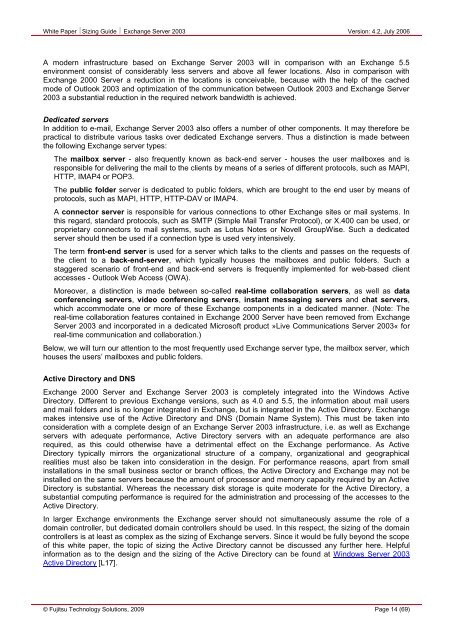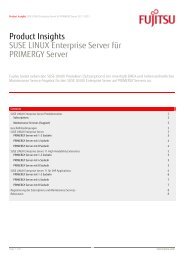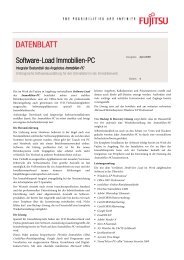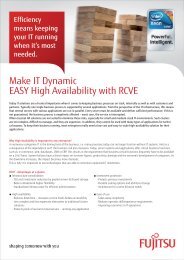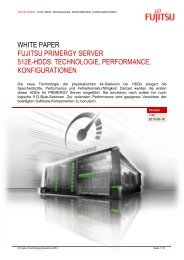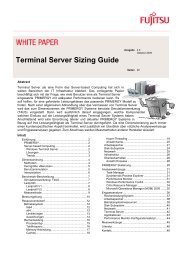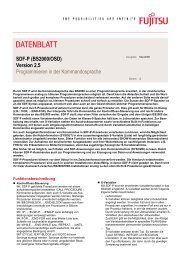Sizing Guide Exchange Server 2003 - Fujitsu
Sizing Guide Exchange Server 2003 - Fujitsu
Sizing Guide Exchange Server 2003 - Fujitsu
Create successful ePaper yourself
Turn your PDF publications into a flip-book with our unique Google optimized e-Paper software.
White Paper <strong>Sizing</strong> <strong>Guide</strong> <strong>Exchange</strong> <strong>Server</strong> <strong>2003</strong> Version: 4.2, July 2006<br />
A modern infrastructure based on <strong>Exchange</strong> <strong>Server</strong> <strong>2003</strong> will in comparison with an <strong>Exchange</strong> 5.5<br />
environment consist of considerably less servers and above all fewer locations. Also in comparison with<br />
<strong>Exchange</strong> 2000 <strong>Server</strong> a reduction in the locations is conceivable, because with the help of the cached<br />
mode of Outlook <strong>2003</strong> and optimization of the communication between Outlook <strong>2003</strong> and <strong>Exchange</strong> <strong>Server</strong><br />
<strong>2003</strong> a substantial reduction in the required network bandwidth is achieved.<br />
Dedicated servers<br />
In addition to e-mail, <strong>Exchange</strong> <strong>Server</strong> <strong>2003</strong> also offers a number of other components. It may therefore be<br />
practical to distribute various tasks over dedicated <strong>Exchange</strong> servers. Thus a distinction is made between<br />
the following <strong>Exchange</strong> server types:<br />
The mailbox server - also frequently known as back-end server - houses the user mailboxes and is<br />
responsible for delivering the mail to the clients by means of a series of different protocols, such as MAPI,<br />
HTTP, IMAP4 or POP3.<br />
The public folder server is dedicated to public folders, which are brought to the end user by means of<br />
protocols, such as MAPI, HTTP, HTTP-DAV or IMAP4.<br />
A connector server is responsible for various connections to other <strong>Exchange</strong> sites or mail systems. In<br />
this regard, standard protocols, such as SMTP (Simple Mail Transfer Protocol), or X.400 can be used, or<br />
proprietary connectors to mail systems, such as Lotus Notes or Novell GroupWise. Such a dedicated<br />
server should then be used if a connection type is used very intensively.<br />
The term front-end server is used for a server which talks to the clients and passes on the requests of<br />
the client to a back-end-server, which typically houses the mailboxes and public folders. Such a<br />
staggered scenario of front-end and back-end servers is frequently implemented for web-based client<br />
accesses - Outlook Web Access (OWA).<br />
Moreover, a distinction is made between so-called real-time collaboration servers, as well as data<br />
conferencing servers, video conferencing servers, instant messaging servers and chat servers,<br />
which accommodate one or more of these <strong>Exchange</strong> components in a dedicated manner. (Note: The<br />
real-time collaboration features contained in <strong>Exchange</strong> 2000 <strong>Server</strong> have been removed from <strong>Exchange</strong><br />
<strong>Server</strong> <strong>2003</strong> and incorporated in a dedicated Microsoft product »Live Communications <strong>Server</strong> <strong>2003</strong>« for<br />
real-time communication and collaboration.)<br />
Below, we will turn our attention to the most frequently used <strong>Exchange</strong> server type, the mailbox server, which<br />
houses the users‟ mailboxes and public folders.<br />
Active Directory and DNS<br />
<strong>Exchange</strong> 2000 <strong>Server</strong> and <strong>Exchange</strong> <strong>Server</strong> <strong>2003</strong> is completely integrated into the Windows Active<br />
Directory. Different to previous <strong>Exchange</strong> versions, such as 4.0 and 5.5, the information about mail users<br />
and mail folders and is no longer integrated in <strong>Exchange</strong>, but is integrated in the Active Directory. <strong>Exchange</strong><br />
makes intensive use of the Active Directory and DNS (Domain Name System). This must be taken into<br />
consideration with a complete design of an <strong>Exchange</strong> <strong>Server</strong> <strong>2003</strong> infrastructure, i.e. as well as <strong>Exchange</strong><br />
servers with adequate performance, Active Directory servers with an adequate performance are also<br />
required, as this could otherwise have a detrimental effect on the <strong>Exchange</strong> performance. As Active<br />
Directory typically mirrors the organizational structure of a company, organizational and geographical<br />
realities must also be taken into consideration in the design. For performance reasons, apart from small<br />
installations in the small business sector or branch offices, the Active Directory and <strong>Exchange</strong> may not be<br />
installed on the same servers because the amount of processor and memory capacity required by an Active<br />
Directory is substantial. Whereas the necessary disk storage is quite moderate for the Active Directory, a<br />
substantial computing performance is required for the administration and processing of the accesses to the<br />
Active Directory.<br />
In larger <strong>Exchange</strong> environments the <strong>Exchange</strong> server should not simultaneously assume the role of a<br />
domain controller, but dedicated domain controllers should be used. In this respect, the sizing of the domain<br />
controllers is at least as complex as the sizing of <strong>Exchange</strong> servers. Since it would be fully beyond the scope<br />
of this white paper, the topic of sizing the Active Directory cannot be discussed any further here. Helpful<br />
information as to the design and the sizing of the Active Directory can be found at Windows <strong>Server</strong> <strong>2003</strong><br />
Active Directory [L17].<br />
© <strong>Fujitsu</strong> Technology Solutions, 2009 Page 14 (69)


